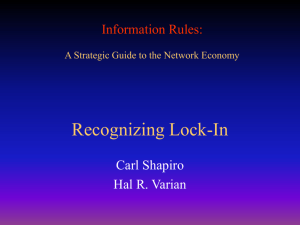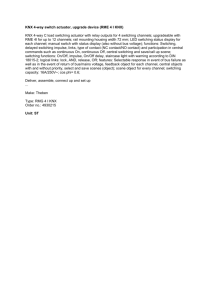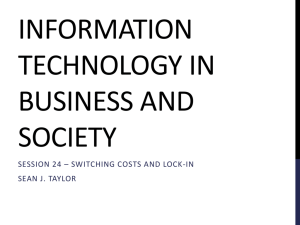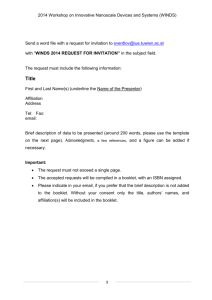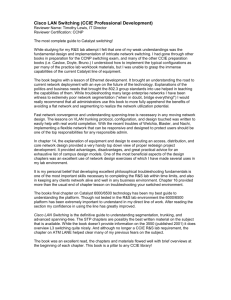Recognizing Lock-In
advertisement
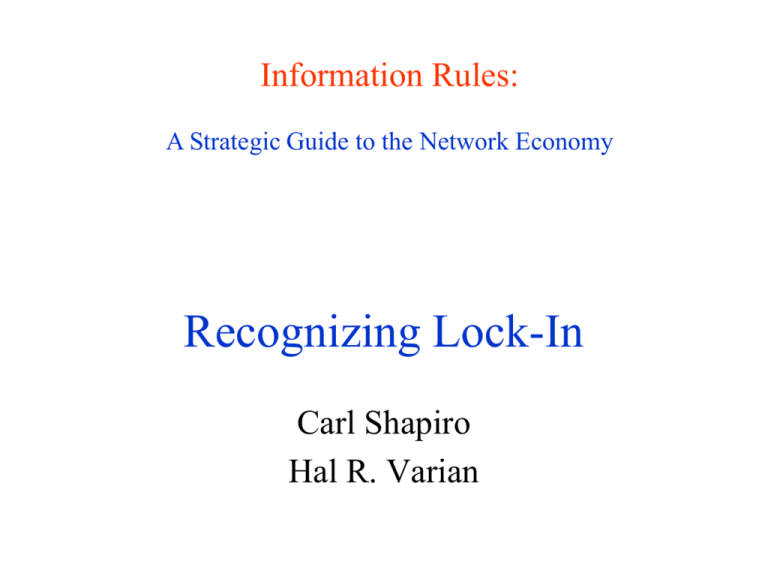
Information Rules: A Strategic Guide to the Network Economy Recognizing Lock-In Carl Shapiro Hal R. Varian The “friction-free” economy delivered by the Internet? • The Year 2000 Problem: a testament to the enormous rigidities that plague the info economy. • Your choice for the future will still be hemmed in by the selections you made in the past. • Understanding the costs of switching(tech or brand) is fundamental to success in today’s economy. Information Rules 2/21 Recognizing Lock-In • Cost of switching: new girl friend? Headaches. Ex is better? • Compare – Hyundai vs. KIA : not much – iPhone vs. Gallexy : can be significant • Definition : Inability to switch from one brand to another due to high switching cost Information Rules 3/21 What’s the Difference? • Durable investments in complementary assets – – Hardware (ex: Mac users switching to PC) Software (ex: Mac users switching to PC) • Supplier wants to lock-in customer • Customer wants to avoid lock-in • Basic principle: Look ahead and reason back Information Rules 4/21 Examples • Bell Atlantic and AT&T 5ESS AT&T – Bell purchased 5ESS digital switch ($3 bil), which used proprietary operating system of AT&T – AT&T charged a lot for upgrade and stuff ($10mil/upgrade) – Large switching costs to change switches • Computer Associates: supplier of IBM compatible mainframe computer software, $3.5 billion in revenue in 1996 ($4.3 bill, 2008), 3rd largest software company • Aircraft repair and cargo conversion Information Rules 5/21 Charles Wang founder of CA Small Switching Costs MatterMass Market Lock-in • Maybe small for individuals, but big for large organizations • Phone number portability (Bell vs. AT&T,MCI, Sprint; interim # portability call forwarding) • Email addresses (America Online vs. other ISP) • Hotmail (advertising, portability) • Look at lock-in costs on a per customer basis: more customers, higher lock-in cost collectively Installed base(기존 고객기반) is a measure of the number of units of a particular type of system (usually a computing platform) actually in use, as opposed to market share, which only reflects sales over a particular period. Information Because installed base includes machines that may have been in use for many years, it is usually a Rules 6/21 higher figure than market share. Many people see it as a more reliable indicator of a platform's popularity. Valuing an Installed Base • Customer switches from KT to "same position" w/ SK – Total switching costs = customer costs + SK's costs – If $25 given by SK to C, total switching costs don’t change – What if 100 minutes free calls($15 value to C, $5 cost to SK)? Total switching cost falls by $10. • How much should you spend? Example – Switching ISPs costs customer $50 + new ISP $25 = $75 (new ISP pays this, including customer’s $50) – If new ISP make $100 on customer, then encourage to switch – If new ISP makes $70 on customer, then do not encourage to switch Information Rules 7/21 Profits & Switching Costs In General: Profit=Switching Cost • Possible Profits from a customer = total switching costs + quality/cost advantages of the service supplier • In commodity market like telephony, profit per customer = total switching costs per customer b/c each company provides the same service, thus no distinct advantage Information Rules 8/21 Profits & Switching Costs In General: •Use of this rule of thumb – Can anticipate how much to invest to get locked-in base (by discounting, advertising etc) – Can evaluate a target acquisition (e.g., Hotmail), instead of figuring out the revenue and costs – Can help inform decisions affecting your customers’ switching cost (product design and compatibility decision if it is too low, make the product incompatible so that switching cost goes up higher switching cost charge more higher profit) Information Rules 9/21 Classification of Lock-In: ways to lock-in • Durable purchases and replacement: (lock-in) declines with time Ex) Vacuum Tube TV • Brand-specific training: rises with time Ex) MS Excel • Information and data: rises with time Ex) Data format • Specialized suppliers: may rise with time Ex) Legal Consulting • Search costs: learn about alternatives Ex) Insurance • Loyalty programs: rebuild cumulative usage Ex) Sky Team • Contractual commitments: by contract Ex) Free Mobile Phones (약정기간 동안 no switching) Information Rules 10/21 Locked-in by Durable Purchases • • • • • ex) Bell Atlantic and AT&T Aftermarket sales (supplies, maintenance) Depends on depreciation Usually fall with time Watch out for multiple pieces of hardware – Supplier will want to stagger vintages – Contract renewal Information Rules 11/21 10 20 30 40 roof roof roof roof Staggered vintages boiler boiler pipes 50 roof boiler roof boiler pipes paint paint paint paint paint paint paint paint Roof: fix every 10 years painting: every 7 years boiler: replace every 15 years Information Rules 60 pipes: replace every 25 years 12/21 Locked-in by Brand-specific Training • Standardization by a single vendor ex) Hangul vs. MS Word • How much is transferable? • Competitors want to lower switching costs – Borland and Quattro Pro help – Word and WordPerfect help – Conversion from HANGUL to Word. Why not work so good? To prevent migration. Information Rules 13/21 Lock-in for Information & Databases • Data files – Insist on standard formats – Hard to import Hangul format into MS Word • Backward Compatibility: Current DVD player can read old formats such as music CDs and video CDs to reduce switching cost to DVD players Information Rules 14/21 Locked-in for Specialized Suppliers • Not just hardware, software too; Advertising, legal, accounting firms are examples of specialized suppliers • ex) of avoidance strategy – Pentagon from Lockheed AND Boeing – IBM from Intel AND AMD Information Rules 15/21 Search Costs • Transactions cost in finding new supplier: Insurance agent, travel agent, etc. • Also costs to be found are borne by new supplier ex) Promotion, closing deal, setting up account, credit risks • Example: Credit Cards companies searching for customers + customer searching for companies – $100 million in receivables is worth about $120 million when sold b/c of market valuation of “loyalty” 정보비대칭성이 거래 이전에 발생 Moral hazard: 도덕적 해이, 정보비대칭성이 거래 이후 발생 Information Rules 16/21 Loyalty Programs - Artificial lock-in, a synthetic friction • Constructed by firm – Frequent flyer programs – Frequent coffee programs • Personalized Pricing – Gold status offered to who has gold status The Green Stamps – Example: More than 10,000 miles/year to sustain the ‘Elite’ status. – If less than 10,000 miles/year, the privilege (20kg vs. 40kg, checking/boarding in with business class) is deprived want to use Korean Air for sure next time. Information Rules 17/21 Contractual Commitments • “Requirements contract”: Purchase supplies from one supplier consider not just price, degraded quality as well. • Need to think about compensatory(to break the contract, you compensate your existing supplier if your new supplier offers a big discount) or liquidated damages (new supplier buys you out of your current contract) • Beware of “evergreen contracts” that renew automatically Information Rules 18/21 Suppliers and partners face lock-in too • Railroad spur lines (coal mine and coalfired power plant) • Customized software (Apple computer, Playstation, Nitendo 64) spur line: very short branch line may be called a spur line Information Rules 19/21 Follow the Lock-in cycle and Anticipate! Changes -Higher or lower switching costs -New techs. 1. Brand Selection 2. Sampling 4. Lock-In Switching cost becomes prohibitively expensive Loyalty program Information Rules Use new brand Take advantage Get used to the new brand 3. Entrenchment 20/21 Ask for sweetener - 8 books for $1 Lessons • Switching costs are ubiquitous (some small, some big but they DO exist) • Customers may be vulnerable • Value your installed base (locked-in customers) to see how much to invest • Watch for durable purchases • Be able to identify 7-types of lock-in Information Rules 21/21
